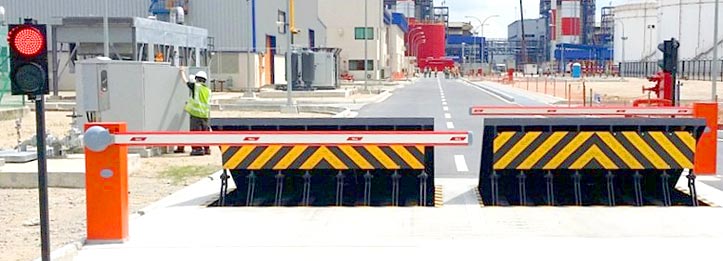What Does Wedge Barriers Do?
Wiki Article
Get This Report about Wedge Barriers
Table of ContentsExamine This Report on Wedge BarriersWedge Barriers Things To Know Before You Get This

Wedge Barriers Fundamentals Explained
The continuing to be force used to the cam to deploy release wedge plate 16 may be provided offered an electromechanical actuator 84 or other various other. The springtime setting up 54 and the actuator 84(e. Wedge Barriers. g., electromechanical actuator)might run together to equate the cam and raise the wedge plate 16.
As discussed over, the spring setting up 54 applies a consistent force on the web cam, while the electromechanical actuator might be managed to apply a variable pressure on the camera, consequently making it possible for the lifting and lowering( i. e., releasing and pulling back )of the wedge plate 16. In specific embodiments, the constant force applied by the springtime assembly 54 might be flexible. g., electromechanical actuator) is handicapped. As will be appreciated, the springtime assembly 54 might be covered and protected from debris or various other components by a cover plate(e. g., cover plate 68 displayed in FIG. 4) that may be significantly flush with the raised surface 38 of the structure 14. As pointed out above, in the deployed position, the wedge plate 16 serves to obstruct accessibility or travel beyond the barrier 10. As an example, the obstacle 10(e. g., the wedge plate 16 )might block pedestrians or automobiles from accessing a residential property or path. As gone over above, the barrier 10 is attached to the anchor 30 safeguarded within the structure 14,

front brackets 71. Therefore, the affiliation assemblies 72 might pivot and rotate to make it possible for the collapse and extension of the link settings up 72 throughout retraction and release of the bather 10. The link assemblies 72 cause motion of the wedge plate 16 to be limited. If a car is taking a trip in the direction of the released wedge plate 16(e. For example, in one situation, the security legs 86 might be extended duringmaintenance of the barrier 10. When the safety and security legs 86 are deployed, the security legs 86 support the weight of the wedge plate 16 versus the surface area 12. Because of this, the training mechanism 50 might be shut down, serviced, eliminated, replaced, etc. FIG. 5 is partial perspective view of a personification of the surface-mounted wedge-style barrier 10, illustrating the cam 80 and the cam surfaces 82 of the training system 50. Specifically, two webcam surface areas Find Out More 82, which are referred to as lower web cam surface areas 83, are placed listed below the webcam 80. The reduced cam surface areas 83 might be repaired to the surface area 12 directory (e. As an example, the lower web cam surfaces 83 and the mounting plate 85 might form a solitary piece that is secured to the support 30 by screws or various other mechanical fasteners. Furthermore, 2 camera surface areas 82, which are described as top webcam surface areas 87, are positioned above the cam 80 and coupled to (e. In other personifications, intervening layers or plates might be positioned between the surface 12 and the lower web cam surfaces 83 and/or the wedge plate 16 and the upper camera surface areas 87 As mentioned over, the webcam 80 translates along the web cam surface areas 82 when the wedge plate 16 is lifted from the retracted setting to the released position. Furthermore, as pointed out above, the springtime assembly 54 (see FIG. 3 )may supply a force acting upon the web cam 80 in the direction 102 using spring pole 58, which might lower the force the electromechanical actuator 84 is called for to use to the cam 80 in order to activate and lift the wedge plate 16. 1 )to the deployed setting(see FIG. 4). As shown, the webcam 80 includes track wheels 104(e. g., rollers), which get in touch with and convert along the cam surfaces 82 throughout procedure.
Report this wiki page